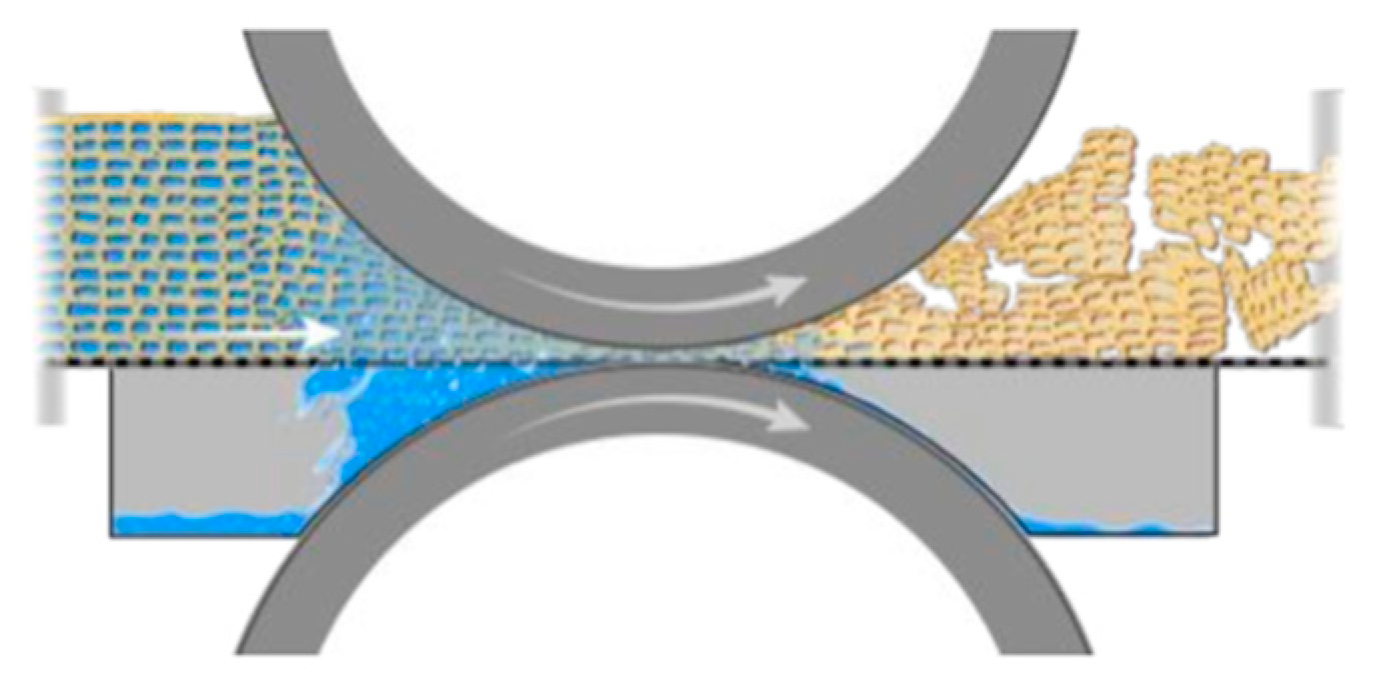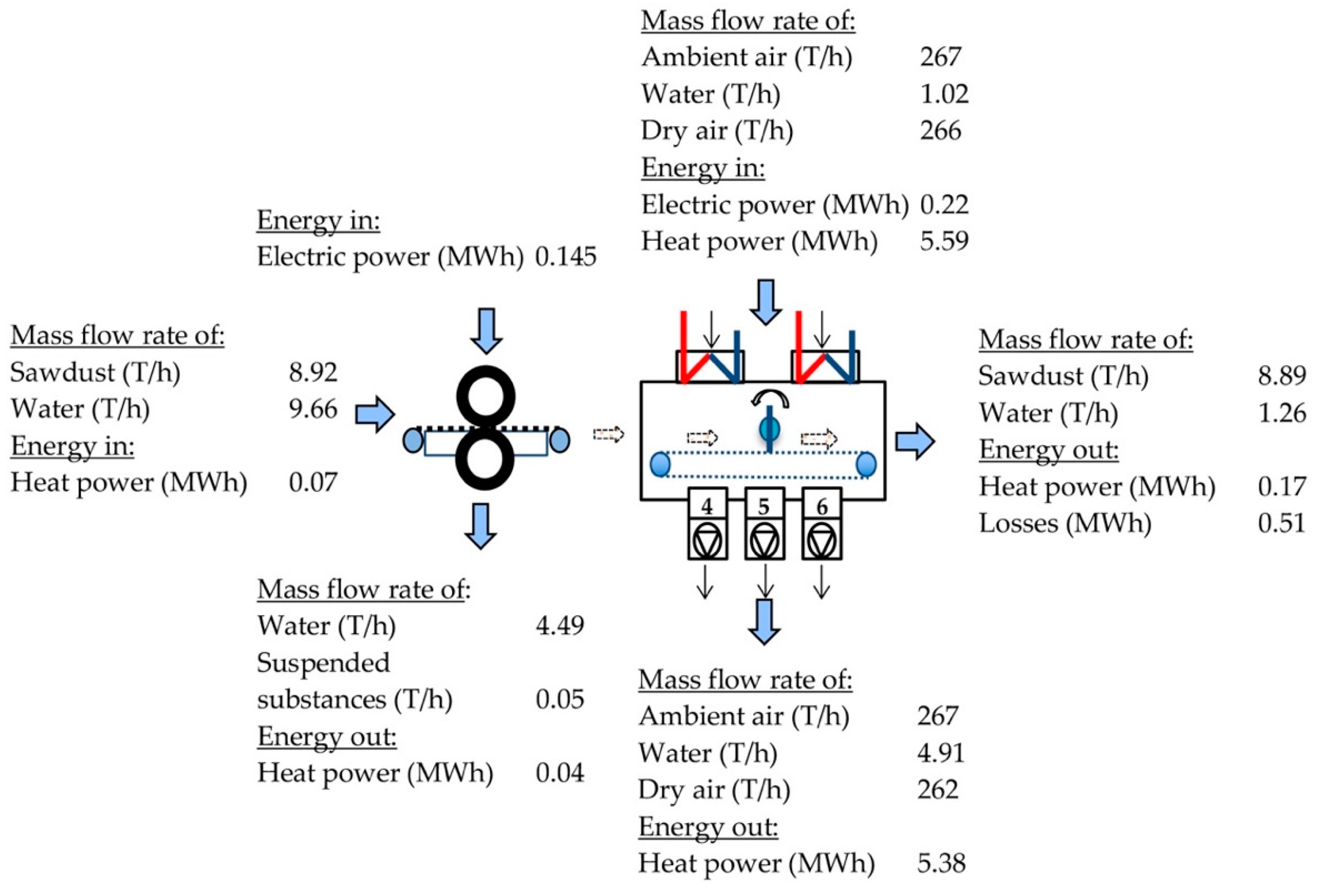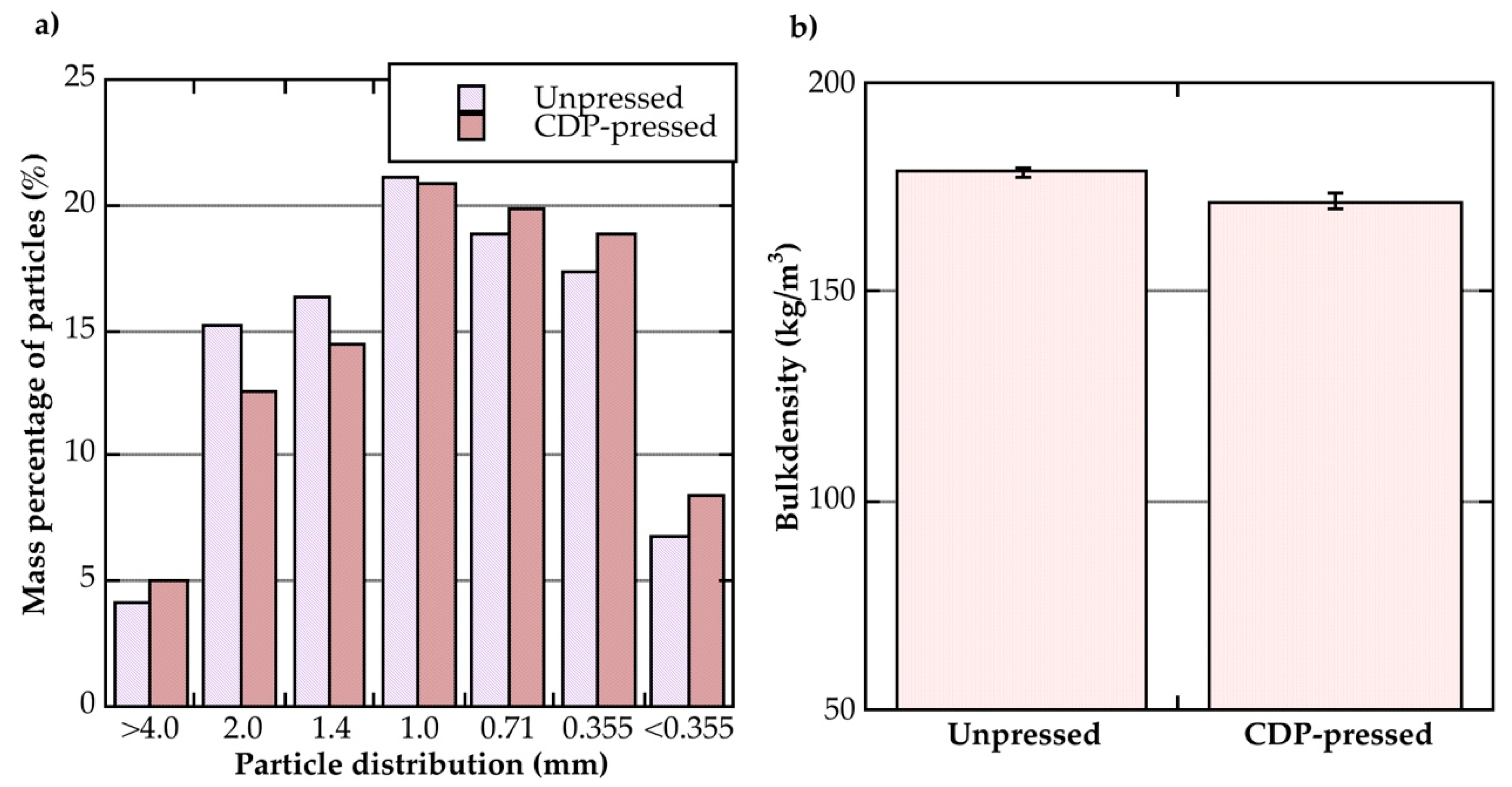The Potential for a Pellet Plant to Become a Biorefinery
Abstract
:1. Introduction
2. Materials and Methods
2.1. The Industrial Packed Moving Bed (PMB) Dryer
2.2. Continuous Dewatering Press (CDP)
2.3. Energy and Mass Balance for the PMB and the CDP + PMB
2.4. Effects of the Mechanical Dewatering Technique on Sawdust
3. Results and Discussion
3.1. Energy and Mass Balances for Concept One
3.2. Energy and Mass Balances for Concept Two
3.3. Effects on the Sawdust When Using the CDP
3.4. The Press Water and Possible New Products
3.5. Further Work
4. Concluding Remarks
Author Contributions
Funding
Acknowledgments
Conflicts of Interest
References
- Stenström, S. Drying of biofuels from the forest—A review. Dry. Technol. 2017, 35, 1167–1181. [Google Scholar] [CrossRef]
- Cherubini, F. The biorefinery concept: Using biomass instead of oil for producing energy and chemicals. Energy Convers. Manag. 2010, 51, 1412–1421. [Google Scholar] [CrossRef]
- Monteiro, E.; Mantha, V.; Rouboa, A. Portuguese pellets market: Analysis of the production and utilization constrains. Energy Policy 2012, 42, 129–135. [Google Scholar] [CrossRef]
- Mani, S.; Sokhansanj, S.; Bi, X.; Turhollow, A. Economics of Producing Fuel Pellets from Biomass. Am. Soc. Agric. Biol. Eng. 2006, 22, 421–426. [Google Scholar] [CrossRef]
- Thek, G.; Obernberger, I. Wood pellet production costs under Austrian and in comparison to Swedish framework conditions. Biomass Bioenergy 2004, 27, 671–693. [Google Scholar] [CrossRef]
- Uasuf, A.; Becker, G. Wood pellets production costs and energy consumption under different framework conditions in Northeast Argentina. Biomass Bioenergy 2011, 35, 1357–1366. [Google Scholar] [CrossRef]
- Wolf, A.; Vidlund, A.; Andersson, E. Energy-efficient pellet production in the forest industry-a study of obstacles and success factors. Biomass Bioenergy 2006, 30, 38–45. [Google Scholar] [CrossRef]
- Andersson, E.; Harvey, S.; Berntsson, T. Energy efficient upgrading of biofuel integrated with a pulp mill. Energy 2006, 31, 1384–1394. [Google Scholar] [CrossRef]
- Ståhl, M.; Granström, K.; Berghel, J.; Renström, R. Industrial processes for biomass drying and their effects on the quality properties of wood pellets. Biomass Bioenergy 2004, 27, 621–628. [Google Scholar] [CrossRef]
- Pang, S.; Mujumdar, A.S. Drying of Woody Biomass for Bioenergy: Drying Technologies and Optimization for an Integrated Bioenergy Plant. Dry. Technol. 2010, 28, 690–701. [Google Scholar] [CrossRef]
- Wimmerstedt, R. Recent advances in biofuel drying. Chem. Eng. Process. Process Intensif. 1999, 38, 441–447. [Google Scholar] [CrossRef]
- Mujumdar, A.S. Principles, Classification, and Selection of Dryers. In Handbook of Industrial Drying, 3rd ed.; CRC Press: Boca Raton, FL, USA, 2006; pp. 3–32. [Google Scholar] [CrossRef]
- Berghel, J. The Effect of Using a Heating Tube in an Existing Spouted Bed Superheated Steam Dryer. Dry. Technol. 2011, 29, 183–188. [Google Scholar] [CrossRef]
- Olazar, M.; Lopez, G.; Altzibar, H.; Amutio, M.; Bilbao, J. Drying of Biomass in a Conical Spouted Bed with Different Types of Internal Devices. Dry. Technol. 2011, 30, 207–216. [Google Scholar] [CrossRef]
- Pang, S. Improving MDF Fibre Drying Operation by Application of a Mathematical Model. Dry. Technol. 2001, 19, 1789–1805. [Google Scholar] [CrossRef]
- Spets, J.-P.; Ahtila, P. Reduction of Organic Emissions by Using a Multistage Drying System for Wood-Based Biomasses. Dry. Technol. 2004, 22, 541–561. [Google Scholar] [CrossRef]
- Frodeson, S.; Berghel, J.; Renström, R. The Potential of Using Two-Step Drying Techniques for Improving Energy Efficiency and Increasing Drying Capacity in Fuel Pellet Industries. Dry. Technol. 2013, 31, 1863–1870. [Google Scholar] [CrossRef]
- Kudra, T. Energy Aspects in Drying. In Handbook of Industrial Drying, 3rd ed.; CRC Press: Boca Raton, FL, USA, 2006; pp. 1075–1101. [Google Scholar] [CrossRef]
- Poirier, D. Conveyor dryers. In Handbook of Industrial Drying, 3rd ed.; CRC Press: Boca Raton, FL, USA, 2006; pp. 411–422. [Google Scholar]
- Borde, I.; Levy, A. Pneumatic and Flash Drying. In Handbok of Industrial Drying, 3rd ed.; CRC Press: Boca Raton, FL, USA, 2006; pp. 397–410. [Google Scholar]
- Ståhl, M.; Berghel, J. Validation of a mathematical model by studying the effects of recirculation of drying gases. Dry. Technol. 2008, 26, 786–792. [Google Scholar] [CrossRef]
- Liu, Z.; Haygreen, J.G. Drying rates of wood chips during compression drying. Wood Fiber Sci. 2007, 17, 214–227. [Google Scholar]
- Haygreen, J.G. Potential for compression drying of green wood chip fuel. For. Prod. J. 1981, 31, 43–54. [Google Scholar]
- Haygreen, J.G. Mechanics of compression drying solid wood cubes and chip mats. For. Prod. J. 1982, 32. [Google Scholar]
- Yoshida, T.; Sasaki, H.; Takano, T.; Sawabe, O. Dewatering of high-moisture wood chips by roller compression method. Biomass Bioenergy 2010, 34, 1053–1058. [Google Scholar] [CrossRef]
- Laurila, J.; Havimo, M.; Lauhanen, R. Compression drying of energy wood. Fuel Process. Technol. 2014, 124, 286–289. [Google Scholar] [CrossRef]
- Impola, R. Kuoren Kasittely Polttoaineeksi-PUUT07. In Proceedings of the VTT Symposium, Jyväskylä, Finland, 28–30 April 2000; pp. 217–232. [Google Scholar]
- Holmberg, A.; Stenström, S. Dewatering and drying of bark. Int. J. Energy Eng. 2014, 4, 8–16. [Google Scholar]
- Askaner, A. Barkpressning. Ph.D. Thesis, Department of Chemical Engineering, Chalmers University of Technology, Gothenburg, Sweden, 1976. [Google Scholar]
- Adachi, K.; Inoue, M.; Kanayama, K. Water removal of wet veneer by roller pressing. J. Wood Sci. 2004, 479–483. [Google Scholar] [CrossRef]
- Wingate-Hill, R.; Cunningham, R.B. Moisture removal from green sapwood during platen pressing. N. Z. J. For. Sci. 1986, 16, 109–117. [Google Scholar]
- Yin, J.; Yuan, T.; Lu, Y.; Song, K.; Li, H.; Zhao, G.; Yin, Y. Effect of compression combined with steam treatment on the porosity, chemical compositon and cellulose crystalline structure of wood cell walls. Carbohydr. Polym. 2017, 155, 163–172. [Google Scholar] [CrossRef]
- Frodeson, S.; Henriksson, G.; Berghel, J. Pelletizing Pure Biomass Substances to Investigate the Mechanical Properties and Bonding Mechanisms. BioResources 2018, 13, 1202–1222. [Google Scholar] [CrossRef]
- Frodeson, S.; Henriksson, G.; Berghel, J. Effects of moisture content during densification of biomass pellets, focusing on polysaccharide substances. Biomass Bioenergy 2019, 122, 322–330. [Google Scholar] [CrossRef]
- Kaliyan, N.; Vance Morey, R. Factors affecting strength and durability of densified biomass products. Biomass Bioenergy 2009, 33, 337–359. [Google Scholar] [CrossRef]
- Whittaker, C.; Shield, I. Factors affecting wood, energy grass and straw pellet durability—A review. Renew. Sustain. Energy Rev. 2017, 71, 1–11. [Google Scholar] [CrossRef]
- Nielsen, N.P.K.; Holm, J.K.; Felby, C. Effect of Fiber Orientation on Compression and Frictional Properties of Sawdust Particles in Fuel Pellet Production. Energy Fuels 2009, 23, 3211–3216. [Google Scholar] [CrossRef]
- Samuelsson, R.; Thyrel, M.; Sjöström, M.; Lestander, T.A. Effect of biomaterial characteristics on pelletizing properties and biofuel pellet quality. Fuel Process. Technol. 2009, 90, 1129–1134. [Google Scholar] [CrossRef]
- Nielsen, N.P.K.; Gardner, D.J.; Felby, C. Effect of extractives and storage on the pelletizing process of sawdust. Fuel 2010, 89, 94–98. [Google Scholar] [CrossRef]
- Samuelsson, R.; Larsson, S.H.; Thyrel, M.; Lestander, T.A. Moisture content and storage time influence the binding mechanisms in biofuel wood pellets. Appl. Energy 2012, 99, 109–115. [Google Scholar] [CrossRef]
- Stelte, W.; Sanadi, A.R.; Shang, L.; Holm, J.K.; Ahrenfeldt, J.; Henriksen, U.B. Recent developments in biomass pelletization—A Review. BioResources 2012, 7, 4451–4490. [Google Scholar]
- Granström, K.M.; Sandberg, M. Characterization of Wood-Dryer Condensate with Assessment of Toxicity to Microorganisms. J. Environ. Eng. 2017, 143, 04017019. [Google Scholar] [CrossRef]
- Ek, M. Rening och Kemisk Karakterisering av Kondensat och Torkgaser från Torkning av Biobränsle: Treatment and Chemical Characterisation of Condensate and Drying Gases from Drying of Biofuel; Värmeforsk: Stockholm, Sweden, 2000; p. 30. [Google Scholar]
- SIS. S.S.I. SS-EN 14774-1 Solid Biofuels—Determination of Moisture Content—Oven Dry Method—Part 1: Total Moisture—Reference Method; SIS Förlag AB: Stockholm, Sweden, 2009. [Google Scholar]
- SIS. S.S.I. SS-EN 15103 Solid Biofuels—Determination of Bulk Density; SIS Förlag AB: Stockholm, Sweden, 2010. [Google Scholar]
- Sandberg, M.; Granström, K.M. A chance at biological treatment for dryer condensates? In Proceedings of the NDC 2011, Helsinki, Finland, 18–21 June 2011. [Google Scholar]
- Berghel, J. Improved Fluidized Bed Drying Technology for Wood Fuels. Ph.D. Thesis, Karlstad University Studies, Karlstad, Sweden, 2004. [Google Scholar]






| PMB | CDP + PMB | |
|---|---|---|
| Inlet average air temperature | 75 °C | 75 °C |
| Heat power delivered to the heat exchangers | 10.1 MW | 5.1 MW |
| Total amount of electric power to the fans in the dryer | 0.450 MW | 0.22 MW |
| Thermal losses from PMB | 10% of inlet power | 10% of inlet power |
| Inlet mass flow sawdust | 18.53 T/h | 18.58 T/h |
| Inlet sawdust moisture content | 52.0% | 52.0% |
| Outlet sawdust moisture content | 12.5% | 12.5% |
| Outlet sawdust moisture content from CDP | - | 36.7% |
| Current load CDP | - | 209 A |
| Voltage CDP | - | 400 V |
© 2019 by the authors. Licensee MDPI, Basel, Switzerland. This article is an open access article distributed under the terms and conditions of the Creative Commons Attribution (CC BY) license (http://creativecommons.org/licenses/by/4.0/).
Share and Cite
Frodeson, S.; Berghel, J.; Ståhl, M.; Granström, K.; Romlin, C.; Thelander, A. The Potential for a Pellet Plant to Become a Biorefinery. Processes 2019, 7, 233. https://doi.org/10.3390/pr7040233
Frodeson S, Berghel J, Ståhl M, Granström K, Romlin C, Thelander A. The Potential for a Pellet Plant to Become a Biorefinery. Processes. 2019; 7(4):233. https://doi.org/10.3390/pr7040233
Chicago/Turabian StyleFrodeson, Stefan, Jonas Berghel, Magnus Ståhl, Karin Granström, Carl Romlin, and Alexander Thelander. 2019. "The Potential for a Pellet Plant to Become a Biorefinery" Processes 7, no. 4: 233. https://doi.org/10.3390/pr7040233
APA StyleFrodeson, S., Berghel, J., Ståhl, M., Granström, K., Romlin, C., & Thelander, A. (2019). The Potential for a Pellet Plant to Become a Biorefinery. Processes, 7(4), 233. https://doi.org/10.3390/pr7040233





